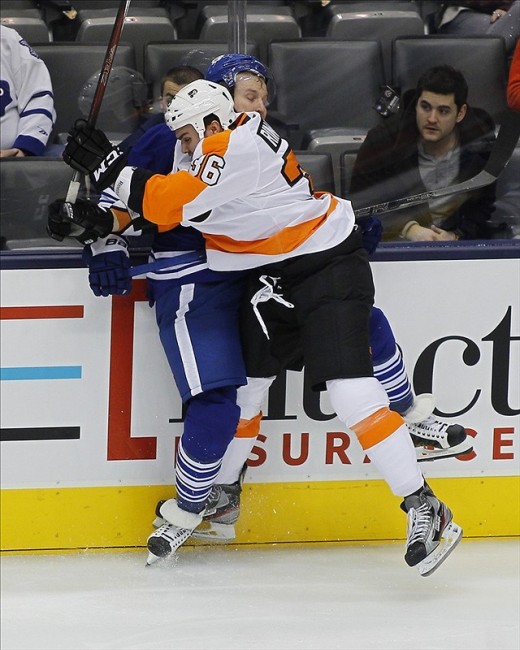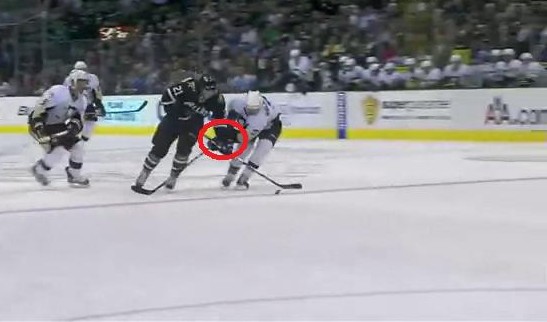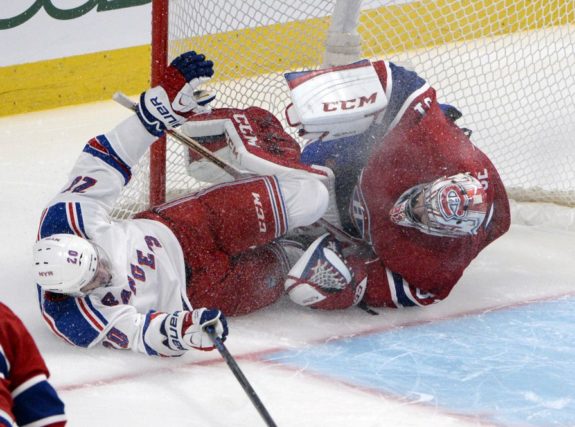This post is part of our series Hockey 101 – geared towards newer fans.
Hitting in hockey is an art form. Timing, points of contact, and technique are all scrutinized by officials closely. Legal hits are taught at very early ages. But if they are timed wrong, an interference penalty can be called. There is a very long explanation of the interference penalty in the NHL Rulebook. Hopefully I can make it easy to understand here.

Not Pass Interference, Just Interference
In short, interference is impeding the progress of an opponent illegally. A player’s body position is defined as the ice beneath his feet and is permitted to impede an opponent if he is moving the same direction. He is allowed to be in the way of an opponent if he has established body position first.
The NHL Rules stipulate a few different criteria for an interference penalty. The player in possession of the puck (or last to have it), whether a player was restrained, if a skater used a “pick,” the use of a free hand, and/or the use of the stick to impede a player’s movement.
Possession
The player who was last had the puck (if no-one has it) or the player in control of the puck is key to interference. He is the only player that can be hit or run into. Any other contact between the nine skaters or two goalies not in possession is considered interference.
Restraint

A player in possession cannot be restrained from the puck unless the defender is in front of him and moving in the same direction. For instance, a forward skates past a defenseman and the defenseman tugs on the player’s jersey as he goes by. That would constitute an interference penalty. The defender lost body position and restrained the player in possession.
The Pick Rule
The pick-and-roll is a key play in basketball. It is not a legal play in the NHL. A player cannot step in front of another that is not in possession of the puck in order to take him out of the play. It is dangerous and can result in serious injury. The NBA doesn’t move at over twenty miles an hour on average, they can bump into each other whenever they like it seems.
Free Hand/Stick
Similar to the restraint, a defending player can only use his body to impede progress. His arms and legs cannot be used to expand the amount of space he occupies. Extending his stick or free hand to block the opposing player, even if the defender has body position, is illegal.
Goaltender Interference

There is a specific penalty for those who commit interference against goaltenders. As they are not skating with the rest of the team, they do not have the ability to defend themselves the way skaters do. Consequently, goaltenders are heavily protected on the ice. Contact with them is rarely ever legal for the reason displayed by the image above. This hit took Carey Price out of the playoffs.
Penalty or Just a Whistle?
There are two instances in which goalies are interfered with. Harmless bumps are not called at all, but when the puck is coming at the goalie, refs keep close eyes on the netminder. For instance, say a goal is scored, but when a goalie gets bumped by an opponent and is prevented from making an attempt at saving the puck on that play, the goal will not count.
Here’s where it gets complicated.
If that opponent was deemed to have accidentally bumped the keeper or was pushed into contact by one of the defending team’s players, it is not a penalty, the play is ended. However, if the player intentionally bumps or is not pushed into the goalie by the goalie’s teammate then it becomes goaltender interference and a penalty is assessed.
Of course, in most other situations, hitting a goaltender is frowned upon. You cannot check a goalie like the other skaters on the ice. If you see a skater bump a goalie, be prepared for a treat as you will watch that keeper flop around to try and earn a call.